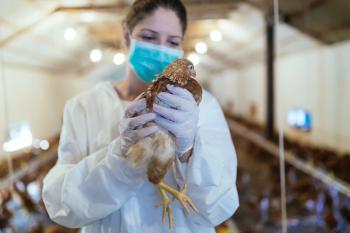
Status COVID-19/Flu A&B Rapid Test
The Status™ COVID-19/Flu A&B - Rapid SARS-CoV-2/Influenza A+B Antigen Panel Test: rapid testing for COVID-19, Flu A&B in one test.
Episodes in this series

Transcript:
Peter Salgo, MD: If you’re going to test separately for the flu and for COVID-19, you need 2 machines or 2 devices, right?
Jason Gallagher, PharmD: That also depends. As George was alluding to, the Abbott machine can do those as 2 tests. The same machine can do 2 tests, but there are 2 separate tests. There are some tests that can do both. One has become recently available that tests for COVID-19, flu A, and flu B on the same card. As we go into these merging seasons, that’s something that can be pretty useful.
Peter Salgo, MD: There’s a new test with a long name. Let me see if I can get this right: the Status COVID-19/Flu A&B rapid SARS-CoV-2/influenza A and B antigen panel test.
Jason Gallagher, PharmD: Yes. It’s not alone in its ability to test for these pathogens. But it’s alone in its ability to do a simple 1 on a little card and get results fairly quickly, because it’s a rapid antigen test. The technology is pretty well known and being utilized to test for this combination of different viruses.
Peter Salgo, MD: Have you guys used this thing? What does it look like? How do you use it? What kind of results does it give you? How do you read it?
George Loukatos, MD: We call it our combo flu and COVID-19 tests for short. But it’s become our mainstay test, especially as we’re going into fall and coming into flu season, because it’s easy to do—it’s 1 swab rather than multiple swabs—and it’s affordable. Basically, it’s collected like other COVID-19 tests. It’s a nasopharyngeal swab that’s mixed with an assay, and that’s put onto a basic chromatographic-type cartridge. After 10 minutes, it tells you whether you have flu A, flu B, or COVID-19.
Peter Salgo, MD: That’s it?
George Loukatos, MD: It’s very simple.
Peter Salgo, MD: Even I could do this.
George Loukatos, MD: Yes, I’m sure you could. It’s very simple to use and very cost effective to me. I keep bringing it back to cost. But especially as a practicing person, you don’t want to order a $400 test on somebody in January when they haven’t met their deductible. Patients aren’t happy when they see a $400 bill for a flu test.
Peter Salgo, MD: In this age, everybody is worried about cost. Who’s paying for this? Is this test reimbursable? Is it covered?
George Loukatos, MD: It is. It’s definitely covered by all our major insurers. The beauty of this test is that it’s affordable to the patient too, because rather than doing 3 separate tests, we’re doing 1 test. It’s lower cost for the patient, and it’s lower cost for me as far as getting my supply in through the door and managing my practice.
Peter Salgo, MD: Do you see the actual purchase or lease of this equipment being cost effective for PCPs [primary care providers] and clinics?
George Loukatos, MD: The beauty of the test that we’re talking about is that there’s no equipment. It’s just the cartridge that comes in prepackaged kits. You don’t need a machine to run it.
Peter Salgo, MD: I see. I misunderstood. It’s just a reader. You just look at it.
George Loukatos, MD: Yes.
Peter Salgo, MD: That’s impressive. I go back to a year ago: How far have we come? We had 2-week delays if you could get tests at all. Now you can go to your private practitioner, the rapid urgent care center, or a pharmacy and get the test. That’s dramatic, isn’t it?
Jason Gallagher, PharmD: Yes. One of the areas that’s been underemphasized is how much better we’ve gotten at testing over the past year and a half. It’s crazy to think about how you couldn’t get tested last March and April because of the lack of availability, and now we’re talking about inexpensive antigen-based testing that can give you an answer in 15 minutes for multiple pathogens potentially available widely.
Peter Salgo, MD: This is very impressive. Before we go crazy on this thing, let’s get some science in here, because the test doesn’t make sense if it’s not any good. What about the sensitivity and specificity for COVID-19, flu A, and flu B? How do you compare all this? Does anybody have these numbers?
George Loukatos, MD: The specificity is very good across the board with most antigen tests. We feel like when we get a positive result, we’re about 98% to 100% confident that it’s accurate, whether it’s flu or COVID-19. The sensitivity is more of a gray area, but all these tests that we’re using are in the low-to-mid-90% range as far as sensitivity. Even our false negative rates are getting pretty low. That’s not that far off from the PCR [polymerase chain reaction] test that we have to wait 24 to 72 hours for results. If there’s a 3% to 5% difference, how clinically relevant is that when you’re talking about a clinic that’s testing 60 or 70 patients a day?
Peter Salgo, MD: This is dramatic. Compare this with the test that requires testing readers. This doesn’t appear to be all that better or worse. It’s about the same, no? Unless I’m missing something.
George Loukatos, MD: It is.
Jason Gallagher, PharmD: It’s essentially the same, so it’s a pretty amazing advance.
Peter Salgo, MD: Let me tie this up for a moment. You’ve got a visual reader, meaning you don’t need a machine. You use a sample, and 15 minutes later, you get an answer. And the answer is as reliable as we had a year ago with the other more cumbersome, far more expensive devices. Bill, where’s the problem here?
William Schaffner, MD: I don’t see much of a problem. The advances in technology, which are extraordinary, will encourage more widespread testing which, as we’ve all been saying, we’re going to need in order to treat patients in the best way going forward as flu and other respiratory viruses hit on top of COVID-19.
Peter Salgo, MD: As we’ve been discussing, if COVID-19 is going to be part of our landscape forever in 1 form or another, like flu, we need to be able to test. As the price comes down and the speed goes up, this is all good, right?
Jason Gallagher, PharmD: Yes. And I’ll take the hit for George and point out the importance of the price, because that’s what allows these things to be widespread. Without it being inexpensive, it won’t happen. In flu season, most years you can make a pretty reasonable clinical assumption based on symptoms, which you can’t do anymore with these 2 respiratory pathogens circulating, potentially at the same time. The testing is critical, and it’s cost that allows that.
Peter Salgo, MD: Jason, as you implied, if it was the distinction without a difference, who’d care? But in fact, we do care, because the treatment pathways diverge.
Jason Gallagher, PharmD: Exactly. One pathway puts you down some oral antivirals, the other 1 either watchful waiting or a potential monoclonal antibody. It allows us to get the right patients to that. It’s critical.
Peter Salgo, MD: Let me ask a crazy question. Are you sitting down for this? Can you foresee a day when you can get this test done at home? You get the test in the mail, or like a pregnancy test. You put a sample on.
George Loukatos, MD: It’s already happening. There’s the BinaxNOW test. When you walk down the aisle in Walmart, you’ll see them sitting on the pharmacy shelf. They’re not the greatest test. Those are in the 70% range as far as sensitivity, so we don’t really use them. But the day has already come when an individual can walk into a pharmacy, pull something off the shelf, and go home and test themselves.
Peter Salgo, MD: But what about the Status test we’re talking about? Is this potentially useful for at-home testing?
George Loukatos, MD: With the advances we’ve made in the last year and a half, I wouldn’t bet against it.
Jason Gallagher, PharmD: It’s certainly possible. I don’t know that I want to do my own nasopharyngeal swab or rely on patients to do that. But if it becomes nasal, a bit of a different sample, then certainly. There’s nothing else technically difficult about it.
Peter Salgo, MD: Before my kids go back to school after breaks, I’ve got to swab them. Then they take the swab to school. I could see that. Prior to that, where it’s going to be in a place like a practitioner’s office, how do you see this being implemented in general practice? Does everybody who comes in with a fever get 1? It’s so cheap and easy. Bill, what do you think?
William Schaffner, MD: All of us are developing our protocols. But as we’ve all been saying, we’re going to be testing an awful lot more this season than we have in the past. That will set the pattern going into the future. Not that we have to go down these various roads, but there are other respiratory viruses out there. We’re increasingly appreciating the importance of respiratory syncytial virus [RSV], in not only kids but adults. That can produce an influenza-like illness. Down the road, I see us getting tests that tell us about that as well. There are therapeutic agents and vaccines in the research pipeline for RSV too. This whole respiratory illness arena is expanding and will continue to expand going forward.
Peter Salgo, MD: I want to thank you for watching this Contagion® Peer Exchange. If you enjoyed the content, please subscribe to our e-newsletters to receive upcoming Peer Exchange segments and other great content right in your in-box.
Transcript edited for clarity.
Newsletter
Stay ahead of emerging infectious disease threats with expert insights and breaking research. Subscribe now to get updates delivered straight to your inbox.























































































































































































































































































































